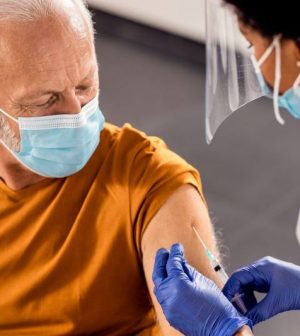- Navigating Your Midlife Crisis: Embracing New Possibilities
- City Raccoons Showing Signs of Domestication
- Mapping the Exposome: Science Broadens Focus to Environmental Disease Triggers
- One Week Less on Social Media Linked to Better Mental Health
- Your Brain Changes in Stages as You Age, Study Finds
- Some Suicide Victims Show No Typical Warning Signs, Study Finds
- ByHeart Formula Faces Lawsuits After Babies Sickened With Botulism
- Switch to Vegan Diet Could Cut Your Greenhouse Gas Emissions in Half
- Regular Bedtime Does Wonders for Blood Pressure
- Dining Alone Could Mean Worse Nutrition for Seniors
Vaccinations Cut U.S. COVID Deaths by 58%: Study

The U.S. COVID-19 vaccination program slashed the coronavirus’ expected death rate by as much as 58%, saving hundreds of thousands of lives during the first two waves of the pandemic, a new study says.
Computer models estimate that vaccines prevented 235,000 COVID deaths in the United States between December 2020 and September 2021, blunting the death toll from both the original virus and its Delta variant.
Vaccination also prevented 1.6 million hospitalizations and 27 million COVID infections, according to the data generated by the U.S. Centers for Disease Control and Prevention. The findings appear July 6 in JAMA Network Open.
The results “reinforce the notion that COVID vaccination clearly does work,” said Dr. William Schaffner, medical director of the National Foundation for Infectious Diseases in Bethesda, Md. “It works very successfully to prevent deaths. And if more people had accepted vaccination, we’d have prevented even more deaths.”
In truth, vaccines probably saved even more lives than estimated here, said lead researcher Molly Steele, a CDC epidemiologist.
“These estimates only account for benefits among those who were vaccinated and do not account for benefits to unvaccinated persons through reductions in disease transmission,” Steele said.
“Therefore, our estimates of vaccine impact are conservative,” she said. “Regardless, these estimates help to illustrate the benefits of COVID-19 vaccines in reducing infections and hospitalizations, as well as saving lives.”
Up to now, no one has established exactly how many COVID illnesses and deaths have been prevented by the three vaccines available in the United States, CDC researchers said in background notes.
To take a stab at it, researchers developed a model that takes into account the estimated risk of infection, hospitalizations and death for specific age groups among the unvaccinated. They then factored the protective effects of vaccination into their numbers.
They determined that vaccination prevented 30% of all expected COVID infections, 33% of all expected hospitalizations, and 34% of all expected deaths among adults between December 2020 and September 2021.
That includes preventing 154,000 deaths among people 65 or older, 66,000 deaths among people 50 to 64, and 14,000 deaths among those 18 to 49, estimates showed.
“COVID-19 vaccination potentially reduced the overall impact of COVID-19 by about one-third,” Steele said. “This means that disease and death would have increased by 30% without vaccination. Thus, if more people were vaccinated against COVID-19, we would expect to see further reductions in the numbers of infections, hospitalizations and deaths.”
What’s more, that protection grew month by month as the vaccination program rolled out and more people became inoculated against COVID, researchers say.
In the month of September 2021, vaccines prevented 58% of expected deaths and 56% of expected hospitalizations, as well as 52% of expected infections.
“The findings are not surprising. The COVID-19 vaccines are unequivocally the best way to prevent the severe consequences of infection, including death,” said Dr. Amesh Adalja, a senior scholar with the Johns Hopkins Center for Health Security.
“The goal of the vaccination program, with first-generation vaccines, was to shift the spectrum of illness to the milder side, to decouple cases from deaths,” Adalja said. “That’s clearly what the data has shown as exemplified by this modeling study.”
Steele added that the study doesn’t tell the whole story, because it’s based on data collected through September 2021.
Therefore, the study “does not reflect more recent updates related to COVID-19 vaccination, including the authorization of booster doses for most age groups, and the expansion of COVID-19 vaccines to children ages 6 months and older,” Steele said.
“As more people continue to get vaccinated and receive boosters, additional COVID-19 hospitalizations and deaths are prevented,” Steele added.
Improved COVID vaccines being developed by Pfizer and Moderna are expected to improve that protection even more, Schaffner said.
“This fall, it’s anticipated that we will have to hand COVID vaccine 2.0, as I like to say,” Schaffner said. “It’s going to be a bivalent vaccine. It will have the antigen we use now, but will have as an addition an antigen related to Omicron and its latest variants.”
The lost opportunity comes in the fact that clinical trials had shown that the vaccines could prevent the risk of death from COVID by up to 94%, according to an editorial published with the study.
One in three Americans remains unvaccinated, the editorial noted, and new strategies are needed to reach those people.
“Without strategies that are evidence informed, we may find ourselves continuing to wonder why the same COVID-19 vaccines that can reduce risk of death by up to 94% only managed to prevent 58% of deaths,” the editorialists wrote.
More information
The U.S. Centers for Disease Control and Prevention has more about COVID vaccines.
SOURCES: William Schaffner, MD, medical director, Bethesda, Md.-based National Foundation for Infectious Diseases; Molly Steele, PhD, MPH, epidemiologist, U.S. Centers for Disease Control and Prevention; Amesh Adalja, MD, senior scholar, Johns Hopkins Center for Health Security; JAMA Network Open, July 6, 2022
Source: HealthDay
Copyright © 2025 HealthDay. All rights reserved.










